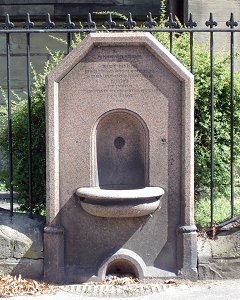|

Listing: 1827-29. By Francis Goodwin. Early English style. The
listing includes the Cooper memorial and the walls, railings and gates.
Literature:
Pevsner: This is .. a Commissioners' church and it is Gothic.
Jill Fellows, A History of St Mary's Church, Bilston 1830 - 1980, published
by the church, 1980
Comment: Not a usual design at all. Its massing
gives it an ark like quality. Contrast this with Goodwin in
classical mode at St. Leonard's.
This is a genuine Commissioners' church in that they provided the whole cost
of £7,749. Perhaps as a result of this there were 538 private pews but 956
free pews. (All the seats became free in 1905).
The petition to the Commissioners was presented in 1825. The site
purchased was "Gozzard's Croft" and cost £907.10.0d. The foundation
stone was not laid until 29th May 1829 and the furniture was not bought
until well in to 1830. So the dates in the listing, 1827-29, perhaps
ought to be 1829-30. The contractors were Samuel Buxton and Son.
The arrangement of the church is odd and the parishioners like to say
that it was built back to front - and that the architect committed suicide
when this was noticed! The tower is at the cardinal and liturgical
east end; but the three doors there, which look as if they ought to be the
main entrance, only give access to two vestries and a passageway which links
the two behind the altar. Inside the east end is not apsidal, as the
exterior would suggest, but presents a large flat wall to the congregation.
The main entrance is where you would expect, at the west end, which end is
also apsidal. It is all very odd but one can hardly suppose that an
architect like Bidlake, closely watched by the Commissioners, made a
mistake. It is made somewhat odder by the stained glass window above
the west entrance, the text on which is arranged to be read from the outside
of the church not, in the usual way, from the inside with the sunlight
coming through.
The Rev. Henry Newbolt was the incumbent from 1860 to 1866. Thus Sir
Henry Newbolt (1862-1938), the patriotic poet, was born in Bilston. He
occasionally returned to Bilston and did so to open the centenary church gala in
1930.
|







